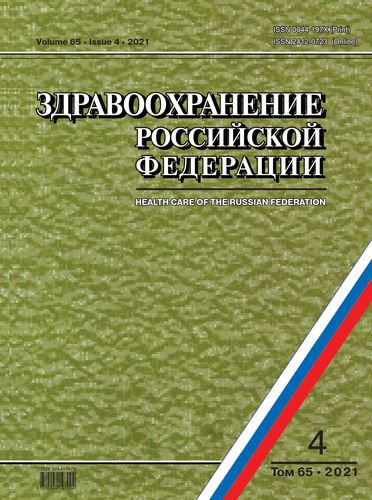Comparative analysis of the dynamics of obesity incidence rates in the Moscow Region population
- Autores: Mikailova O.M.1
-
Afiliações:
- Office of the Federal Service for Supervision of Consumer Rights Protection and Human Wellbeing for the Moscow Region
- Edição: Volume 65, Nº 4 (2021)
- Páginas: 318-324
- Seção: PREVENTION OF NONINFECTIOUS DISEASES
- ##submission.dateSubmitted##: 25.10.2024
- URL: https://hum-ecol.ru/0044-197X/article/view/637706
- DOI: https://doi.org/10.47470/0044-197X-2021-65-4-318-324
- ID: 637706
Citar
Texto integral
Resumo
Introduction. One of the mechanisms for implementing the state policy targets in achieving wellbeing, improving the quality and duration of active life, reducing mortality, including at working age, is to reduce risks and eliminate factors that contribute to the development of obesity.
The aim of the study is a hygienic assessment of the indicator of the primary morbidity of obesity in the population of the Moscow Region, the Central Federal District (CFD), the Russian Federation (RF).
Materials and methods. The research materials were the databases of the regional information fund for social and hygienic monitoring of the Moscow Region for 2011–2019 (2020). The study was performed by a retrospective comparative analysis of intensive indicators of the primary morbidity of obesity in three age groups, calculated for 100 thousand cases of the corresponding age.
Results. Obesity of the population of the Moscow Region occupies a significant share in the structure of diseases of the endocrine system, eating disorders and metabolic disorders. Among children, the incidence is 34.1% of all diseases of this class, among adolescents – 44.2%, adults-21.4%. The incidence of obesity among all age categories of the population of the Moscow Region is significantly lower than the level of the same indicator for the Central Federal District and for the Russian Federation, excluding the period 2011–2014, when the incidence of adolescents in the Moscow Region was higher or at the level of the indicator values for Russia. In 2019. among the 18 subjects of the Central Federal District, the Moscow Region occupies the 16th rank position in descending order of the value of the indicator of obesity among adolescents and adults for the first time. The lowest indicator for the Central Federal District is established among children.
Conclusion. The implementation of the measures of the federal project “Strengthening Public Health” aimed at providing the population with a full, balanced, rational diet will reduce the risk of alimentary diseases, including obesity.
Sobre autores
Olga Mikailova
Office of the Federal Service for Supervision of Consumer Rights Protection and Human Wellbeing for the Moscow Region
Autor responsável pela correspondência
Email: mikailova-om@yandex.ru
ORCID ID: 0000-0003-3842-6368
MD, PhD, Head of the Office of the Federal Service for Supervision of Consumer Rights Protection and Human Welfare in the Moscow Region, Mytishchi, Moscow Region, 141014, Russian Federation.
e-mail: mikailova-om@yandex.ru
RússiaBibliografia
- Larionova M.A., Kovalenko T.V. Epidemiological features of obesity in children and adolescents in the Udmurt Republic. Ozhirenie i metabolizm. 2019; 16(1): 47–54. https://doi.org/10.14341/omet9612 (in Russian)
- WHO. Fact Sheet. Obesity and Overweight. Available at: https://www.who.int/news-room/fact-sheets/detail/obesity-and-overweight
- Kartelishev A.V., Rumyantsev A.G., Smirnova N.S. Obesity in Children and Adolescents. Causes and Modern Technologies of Therapy and Prevention. [Ozhirenie u detey i podrostkov. Prichiny i sovremennye tekhnologii terapii i profilaktiki]. Moscow: Binom; 2013. (in Russian)
- Latyshev O.Yu., Kiseleva E.V., Okminyan G.F. Prevalence of metabolic syndrome and its components in obese children and adolescents. In: Issues of Childhood Obesity: Materials of the X All-Russian Scientific and Practical Conference «Topical Issues of Pediatric Diabetology and Endocrinology» [Voprosy detskogo ozhireniya: materialy X Vserossiyskoy nauchno-prakticheskoy konferentsii «Aktual’nye voprosy detskoy diabetologii i endokrinologii»]. St. Petersburg; 2014. (in Russian)
- Freedman D.S., Dietz W.H., Srinivasan S.R., Berenson G.S. the relation of overweight to cardiovascular risk factors among children and adolescents: The Bogalusa Heart Study. Pediatrics. 1999; 103(6): 1175–82. https://doi.org/10.1542/peds.103.6.1175
- Dedov I.I., Mel’nichenko G.A., eds. Obesity: Etiology, Pathogenesis, Clinical Aspects [Ozhirenie: etiologiya, patogenez, klinicheskie aspekty]. Moscow: MIA; 2004. (in Russian)
- Maskova G.S., Chernaya N.L., Shubina E.N., Aleksandrova S.V. The age features of primary obesity in children. Prakticheskaya meditsina. 2014; 85(9): 126–30. (in Russian)
- Tutel’yan V.A., Baturin A.K., Kon’ I.Ya., Martinchik A.N., Uglitskikh A.K., Korosteleva M.M., et al. The prevalence of obesity and overweight among the children’s population of the Russian Federation: a multicenter study. Pediatriya. Zhurnal im. G.N. Speranskogo. 2014; 93(5): 28–31. (in Russian)
- Kon’ I.Ya., Volkova L.Yu., Korosteleva M.M., Shilina N.M., Aleshina I.V., Toboleva M.A. Incidence of obesity in children of preschool and school age in the Russian Federation. Voprosy detskoy dietologii. 2011; 9(4): 5–8. https://doi.org/10.20953/1727-5784-2011-4-5-8 (in Russian)
- Dedov I.I., Mel’nichenko G.A., Butrova S.A., Savel’eva L.V., Bodaveli O.V., Buydina T.A., et al. Obesity in adolescents in Russia. Ozhirenie i metabolizm. 2006; 3(4): 30–4. https://doi.org/10.14341/2071-8713-5141 (in Russian)
Arquivos suplementares









